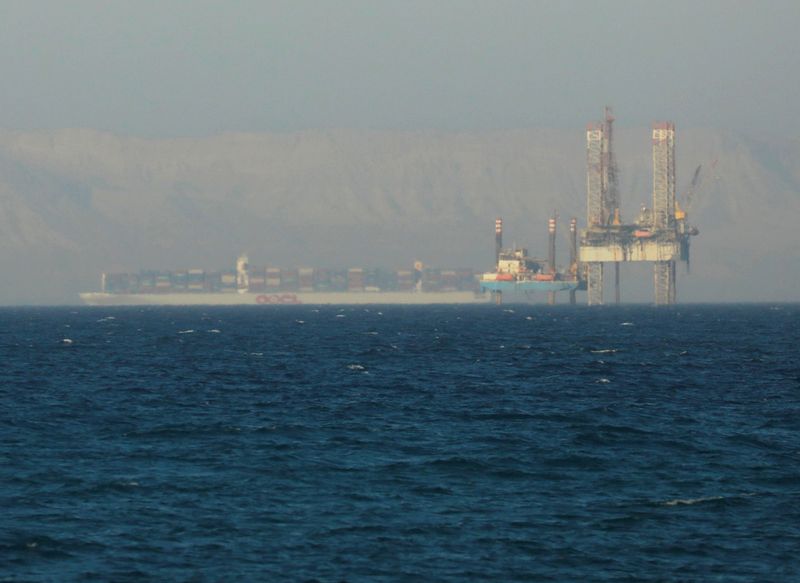Commodities
Oil settles up on Red Sea tensions; gains capped by US stock builds


© Reuters. FILE PHOTO: A container ship crosses an oil platform at the Gulf of Suez towards the Red Sea before entering the Suez Canal, outside of Cairo, Egypt September 1, 2020. REUTERS/Amr Abdallah Dalsh/File Photo
By Laura Sanicola
(Reuters) -Oil prices settled slightly higher after a choppy trading session on Wednesday as investors worried about global trade disruption and tensions in the Middle East following attacks on ships by Yemen’s Iran-aligned Houthi forces in the Red Sea.
Limiting price gains were a surprise inventory build, larger than expected fuel stocks gains and record domestic oil production.
futures settled up 47 cents, or 0.6%, at $79.70 a barrel, while U.S. West Texas Intermediate crude settled up 28 cents, or 0.4%, to $74.22 a barrel.
Both benchmarks briefly turned negative following the EIA report and the possibility of a new ceasefire after the leader of Hamas paid his first visit to Egypt for more than a month.
Early in the session, the benchmarks rose by more than $1 as major maritime carriers chose to steer clear of the Red Sea route, with longer voyages increasing transport and insurance costs.
On Wednesday, Greece advised commercial vessels sailing in the Red Sea and the Gulf of Aden to avoid Yemeni waters. Greek ship owners control about 20% of the world’s commercial vessels in terms of carrying capacity.
“The possibility of a significant price downturn would appear likely on first suggestion of stabilization of cargo transits through the Red Sea corridor,” said John Ritterbusch, president of Ritterbusch and Associates LLC in Galena, Illinois.
On Tuesday, Washington launched a task force to safeguard commerce in the region. Sources including shipping and maritime security officials told Reuters that few practical details are known about the initiative or whether it will directly engage in the event of further armed attacks.
The Houthis vowed to defy the U.S.-led naval mission and to keep targeting Red Sea shipping in support of Palestinian enclave Gaza’s ruling Hamas movement.
About 12% of world shipping traffic passes up the Red Sea and through the Suez Canal. Although oil supply has been realigned, no shortages have yet emerged, analysts said.
“As long as production is not threatened, the market will eventually adjust to changing supply routes,” said Ole Hansen, an analyst at Saxo Bank.
ECONOMIC GREEN SHOOTS
Recent data suggests central bank action to quell sticky inflation in Europe had made a meaningful difference.
German producer prices fell more than expected in November, data showed on Wednesday, a day after it was confirmed that euro zone inflation slowed sharply to 2.4% last month on a year-on-year basis.
A European Central Bank policymaker cautioned it was “rather unlikely” interest rates would be cut during the first six months of next year.
In Britain, inflation plunged in November to its lowest rate in more than two years, strengthening the case for rate cuts.
On Tuesday, the U.S. Energy Department said the government bought 2.1 million barrels of crude for delivery in February, as the U.S. continues to replenish reserves.
Commodities
Oil prices rise; U.S. crude inventories plunge, Russia-Ukraine truce eyed
Commodities
India’s Reliance to stop buying Venezuelan oil over US tariffs, sources say
Commodities
Oil prices climb on Venezuela supply worries

 Forex3 years ago
Forex3 years agoForex Today: the dollar is gaining strength amid gloomy sentiment at the start of the Fed’s week

 Forex3 years ago
Forex3 years agoUnbiased review of Pocket Option broker

 Forex3 years ago
Forex3 years agoDollar to pound sterling exchange rate today: Pound plummeted to its lowest since 1985

 Forex3 years ago
Forex3 years agoHow is the Australian dollar doing today?

 Cryptocurrency3 years ago
Cryptocurrency3 years agoWhat happened in the crypto market – current events today

 World3 years ago
World3 years agoWhy are modern video games an art form?

 Commodities3 years ago
Commodities3 years agoCopper continues to fall in price on expectations of lower demand in China

 Economy3 years ago
Economy3 years agoCrude oil tankers double in price due to EU anti-Russian sanctions























